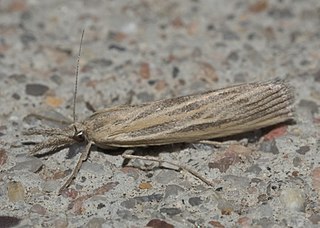
Thaumatopsis is a genus of moths of the family Crambidae.

Taniva is a monotypic moth genus belonging to the family Tortricidae erected by Carl Heinrich in 1926. Its only species, Taniva albolineana, the spruce needleminer moth, was first described by William D. Kearfott in 1907.
Fissicrambus intermedius is a moth in the family Crambidae. It was described by William D. Kearfott in 1908. It has been recorded from the US states of Arizona, California and Texas.
Microcrambus polingi is a moth in the family Crambidae. It was described by William D. Kearfott in 1908. It is found in the US state of Arizona.

Pediasia dorsipunctella is a moth in the family Crambidae. It was described by William D. Kearfott in 1908. It is found in North America, where it has been recorded from Alberta, Arizona, California, Manitoba, Montana, Nevada, North Dakota and Ontario. The habitat consists of grasslands.
Thaumatopsis actuellus is a moth in the family Crambidae. It was described by William Barnes and James Halliday McDunnough in 1918. It is found in North America, where it has been recorded from Florida and Texas.
Thaumatopsis atomosella is a moth in the family Crambidae. It was described by William D. Kearfott in 1908. It is found in the US states of Arizona and California.
Thaumatopsis crenulatella is a moth in the family Crambidae. It was described by William D. Kearfott in 1908. It is found in the US states of Arizona, California, Colorado and Nevada.
Thaumatopsis edonis is a moth in the family Crambidae. It was described by Augustus Radcliffe Grote in 1880. It is found in North America, where it has been recorded from Florida, Kentucky, Maine, Massachusetts, Mississippi, Missouri, Nebraska, New Jersey, Oklahoma and South Carolina. It is listed as threatened in the US state of Connecticut.
Thaumatopsis fieldella is a moth in the family Crambidae. It was described by William Barnes and James Halliday McDunnough in 1912. It is found in North America, where it has been recorded from California.
Thaumatopsis floridella, the Floridian grass-veneer, is a moth in the family Crambidae. It was described by William Barnes and James Halliday McDunnough in 1913. It is found in North America, where it has been recorded from coastal areas in Florida, Georgia, Mississippi, South Carolina and North Carolina, New Jersey, New York, and Rhode Island. It is also found in Cuba.

Thaumatopsis pexellus, the woolly grass-veneer, is a moth in the family Crambidae. It was described by Philipp Christoph Zeller in 1863. It is found in most of North America. The habitat consists of grasslands.
Thaumatopsis repandus is a moth in the family Crambidae. It was described by Augustus Radcliffe Grote in 1880. It is found in North America, where it has been recorded from Arizona, British Columbia, California, Colorado, New Mexico, Oregon and Washington.
Eoreuma multipunctellus is a moth in the family Crambidae. It was described by William D. Kearfott in 1908. It has been recorded from the US state of Arizona.
Xubida puritellus is a moth in the family Crambidae. It was described by William D. Kearfott in 1908. It is found in the US state of Arizona.
Hemiplatytes parallela is a moth in the family Crambidae. It was described by William D. Kearfott in 1908. It is found in the US states of Arizona and New Mexico.
Mesolia baboquivariella is a moth in the family Crambidae. It was described by William D. Kearfott in 1907. It is found in the US state of Arizona.

Lipocosma adelalis is a moth in the family Crambidae. It was described by William D. Kearfott in 1903. It is found in the US states of Indiana, Mississippi, Missouri, New Jersey, North Carolina, Ohio, South Carolina, Tennessee and West Virginia.
Ochromolopis ramapoella is a moth in the family Epermeniidae. It was described by William D. Kearfott in 1903. It is found in North America, where it has been recorded from Alberta, Illinois, Indiana, Kentucky, Manitoba, Michigan, New York, Ohio and Quebec.
Epermenia cicutaella is a moth in the family Epermeniidae. It was described by William D. Kearfott in 1903. It is found in North America, where it has been recorded from California, Delaware, Kentucky, Michigan, New Brunswick, New Hampshire, New Jersey, New York, Nova Scotia, Oregon, Quebec, and Wyoming.



